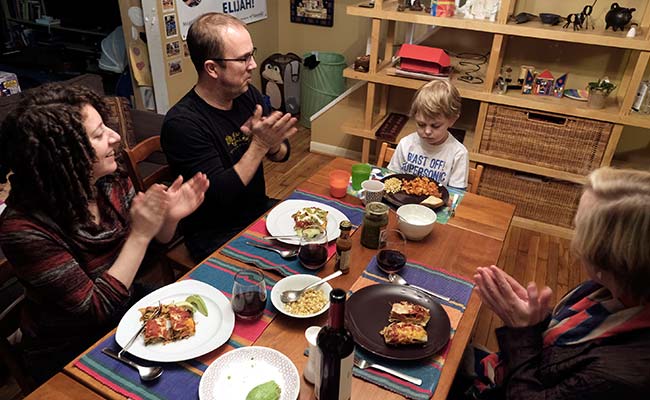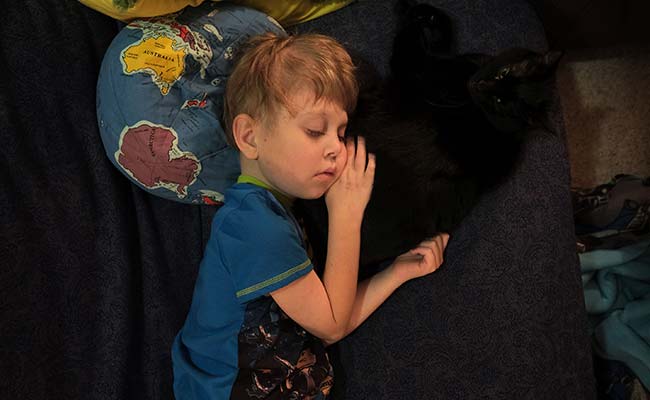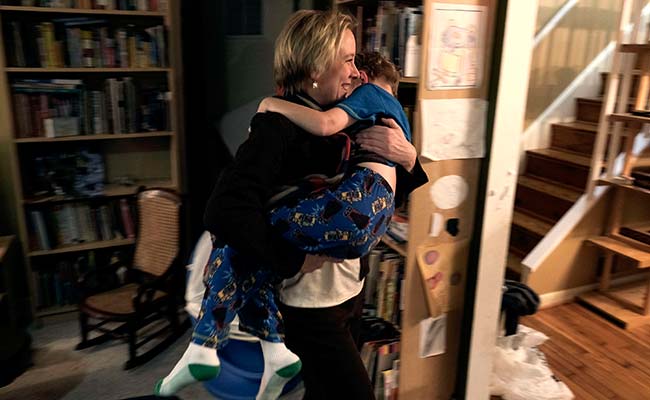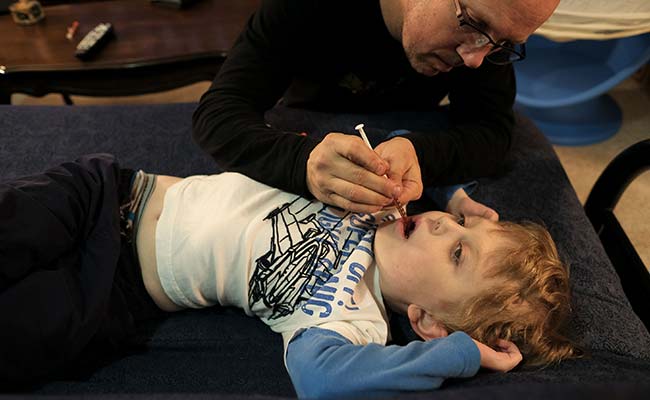
Brad Simpson's son, Elijah Simpson-Sundell, was diagnosed with a brain tumor last spring.
It was the most ordinary of family dinners, with pizza and cauliflower. Two exhausted parents sipped red wine. Two children giggled over silly jokes and squabbled over a stuffed animal named Baby Jaguar.
A few moments later, 8-year-old Elijah Simpson-Sundell, his face slightly swollen and his speech slurred, walked unsteadily away from the table. His father gently reproached 6-year-old Genevieve: "When your brother wants something, and he doesn't feel well, we should try to accommodate him."
For months this Rockville, Maryland, family has veered between such quiet prescriptions and desperate searches. They've flown repeatedly to Europe, to a clinic that is one of the few places anywhere offering a fragment of hope. Along the way, Brad Simpson and Kristin Sundell have discovered a small community of families grappling with the same unimaginable scenario - a child with a rare, universally fatal brain tumor.
 Amid the progress being made on other fronts in oncology, children's cancers present a particular challenge given the lesser attention and research funding that many get. One of those is DIPG, letters that Elijah's parents heard for the first time with his diagnosis. Diffuse intrinsic pontine glioma is a doubly devastating tumor: Not only is it intractable, infiltrating the brain stem in a way that makes surgery impossible, but it affects only young children.
Amid the progress being made on other fronts in oncology, children's cancers present a particular challenge given the lesser attention and research funding that many get. One of those is DIPG, letters that Elijah's parents heard for the first time with his diagnosis. Diffuse intrinsic pontine glioma is a doubly devastating tumor: Not only is it intractable, infiltrating the brain stem in a way that makes surgery impossible, but it affects only young children.
Astronaut Neil Armstrong's 2-year-old daughter died of the disease in 1962, and treatments today are no more successful. Until recently, physicians didn't even conduct biopsies. Without tissue, the disease couldn't be studied. All of that is changing, with research accelerating, but treatments remain years away.
In such a bleak landscape, Elijah's story is remarkable because of the lengths to which his parents have gone to try to save him. Yet it is also unremarkable - because others have done the same for their children.
 "As parents, you are facing not just overwhelming odds but zero odds," Simpson said. "You will do anything."
"As parents, you are facing not just overwhelming odds but zero odds," Simpson said. "You will do anything."
- - -
Almost 4,000 miles away in Cologne, Germany, is the private clinic that his family sought out. It's one of the few places in the world offering immunotherapy for DIPG. The centerpiece of its effort is a vaccine made from each patient's own white blood cells and tumor antigens, which are proteins that produce an immune response. The goal is to allow the immune system to recognize and attack the cancer.
After 18 months and 29 children, the results are "encouraging," said pediatric oncologist Stefaan van Gool. But it's far too early to know whether the approach extends survival. "We have to wait," he acknowledged.
Elijah has flown to Cologne three times since October, twice with his father and once with his mother. In between sessions at the clinic, he visited the Schokoladenmuseum - the Chocolate Museum - played cards and made friends with some of the other young patients.
If only he'd been diagnosed five years from now, things might be different, doctors in the United States have told his parents. Much is being learned about the disease, and several clinical trials are being planned or started to test new approaches.
The family's reality, however, is the here and now.
Elijah, says his father, "almost certainly won't benefit from the research."
- - -
He is a fan of Star Wars, Pokemon and the color orange. He's fond of soccer but also the piano. All in all, a pretty typical 8-year-old boy - until his medical history is added into the mix.
Elijah was born with a skull malformation that was corrected surgically when he was a baby. As he grew, he remained smaller and less physically robust than his peers. And then, about a year ago, he became increasingly sluggish.
 "His speech got slower," remembers his mother, director of aid effectiveness at the nonprofit Save the Children. "And then one weekend his foot turned in and he lost his balance."
"His speech got slower," remembers his mother, director of aid effectiveness at the nonprofit Save the Children. "And then one weekend his foot turned in and he lost his balance."
Sundell took Elijah to his pediatrician, who immediately sent them to Children's National Medical Center. She called her ex-husband, an associate professor of history and Asian studies at the University of Connecticut. Simpson jumped in his car and met them at the hospital hours later.
Within days, a genetic test confirmed Elijah had DIPG's classic mutation.
The disease attacks the brain stem, which controls essential functions such as heart rate, breathing and swallowing, with brutal efficiency; its victims lose their ability to walk, talk, even smile. About 200 to 400 youngsters are diagnosed in the United States every year, and half are gone within nine months. Ninety percent are dead within two years.
"The extreme cruelty of this disease is that it steals each function of the body one by one, from a child who is mentally intact," said Jenny Mosier, whose son Michael was diagnosed shortly after starting kindergarten in 2014. He died the following spring. "It is the worst of the worst."
No drugs work against DIPG, and radiation treatments provide only a temporary reprieve. So patients often are enrolled immediately in clinical trials. But nothing appropriate for Elijah was open at the time. He underwent several weeks of radiation to try to shrink his tumor and relieve some of his symptoms. Exhausted, he used a wheelchair when he returned to school in late spring.
His second-grade classmates greeted him with a huge conga line and took turns pushing him around the playground.
"You realize the tremendous capacity of young children for love and empathy," Simpson said.
 The boy rebounded, and in September his neuro-oncologist at Children's, Lindsay Kilburn, put him on panobinostat, a drug that has been shown to inhibit DIPG tumor growth in mice. His parents added daily doses of cannabis oil, which some people think has anti-cancer properties. That same month, the family traveled to South Africa for a safari, courtesy of the Make-A-Wish Foundation. The elephants and giraffes were cool, but it was the dung beetles that really grabbed Elijah's attention, because they live off other animals' feces.
The boy rebounded, and in September his neuro-oncologist at Children's, Lindsay Kilburn, put him on panobinostat, a drug that has been shown to inhibit DIPG tumor growth in mice. His parents added daily doses of cannabis oil, which some people think has anti-cancer properties. That same month, the family traveled to South Africa for a safari, courtesy of the Make-A-Wish Foundation. The elephants and giraffes were cool, but it was the dung beetles that really grabbed Elijah's attention, because they live off other animals' feces.
Yet the clock was conspiring against him. Ninety-five percent of DIPG tumors return five to nine months after children finish their radiation treatments. Elijah's had ended in June.
With no additional options, his increasingly frantic parents decided to take him to the IOZK clinic in Germany. Other U.S. families had been buzzing about it in online forums. Simpson and Sundell set up a conference call between van Gool and Kilburn. She didn't try to dissuade them from going.
The first trip was in October, with an eight-day treatment followed by a three-week break. Then it was back to Cologne in November and again in December. Each time, doctors started by giving Elijah infusions of a virus designed to infect and mark the cancer cells. They also used hyperthermia, exposing his tumor to heat to try to damage it. Finally, he got a tailor-made vaccine combining his white blood cells and proteins from his tumor.
The three-round package cost about $45,000 and wasn't covered by insurance. Elijah's parents turned to family, friends and sympathetic strangers for financial help. They appealed via Facebook and the crowdsourcing site YouCaring.org and raised tens of thousands of dollars to cover the treatments, airfare and lodging.
"The only silver lining to this is all the people who have come out to support us," Sundell said. "It's really humbling."
- - -
Relatively few doctors and researchers around the world focused much on DIPG until recently. A father whose little girl was diagnosed remembers a researcher telling him the disease was "a career killer" because of its hopeless nature.
The lack of tissue for studies was the biggest obstacle to understanding the cancer. Since a tumor could be diagnosed by MRI, doctors didn't perform biopsies. Too dangerous, they thought, and possibly unethical given the lack of available treatments.
But things began to change about a decade ago. European researchers showed that biopsies could be done safely. And more parents around the world began donating tissue following a child's death. In 2010, Stanford University pediatric neurologist Michelle Monje used a donation to create the world's first DIPG cell line. The disease could now be studied in the laboratory.
Two years later, two groups of scientists made the same striking discovery: Nearly 80 percent of DIPG tumors have mutations in a histone gene - a protein that packages DNA. Researchers also realized that these tumors were nothing like adult brain tumors, which might partly explain the failure of more than 200 trials with conventional chemotherapy. They were making more progress than in decades.
Efforts now are focused on finding novel drugs aimed at DIPG's mutations, testing immunotherapies and developing new ways to get drugs right to the tumor. Beating the disease will likely require a combination of approaches.
Mark Souweidane, a pediatric neurosurgeon at Memorial Sloan Kettering Cancer Center, just completed an early-stage trial in which he surgically implanted small catheters in patients' brainstems. He then delivered high volumes of drugs directly to their tumors, circumventing the protective blood-brain barrier.
"I have never been more convinced that we are onto something that has great promise," he said.
Much of the push for stepped-up efforts has come from parents who have lost their children to the disease. Jonathan Agin, a Washington attorney whose daughter died in 2011, is now a full-time advocate. The DIPG Collaborative, formed to increase several groups' clout and fundraising, has repeatedly pressed for more aggressive research.
"It goes without saying that no one wants to harm kids," Agin noted. "But the notion of 'first, do no harm,' when taking no aggressive action means certain death, doesn't sit well with a community of parents who continue to watch children die, over and over again."
- - -
In Rockville, moments of heart-stopping kindness continue to encircle Elijah.
After he returned from his third trip to Cologne in December, his school held an "Orange Day" in his honor. Hundreds of students donned orange T-shirts, and dozens of adults, most of whom didn't know him, came dressed as Star Wars characters. Darth Vader took Elijah by the hand and walked him down the hall for a special ceremony. A phalanx of Stormtroopers followed, wearing pins that read "May the force be with you, Elijah."
"Every day I feel like I'm on the edge of an abyss," his father said. "The only thing keeping me from falling off are the little mundane moments of joy and compassion."
In mid-January, Elijah's parents got an email from van Gool saying he was satisfied with the boy's response to the therapy and suggesting he come back once a month for several short treatments. The next visit is set for later this week.
Yet nothing stops his parents' worrying - over the tumor's likely return, his worsening problems walking and talking, his poor appetite. At 46 pounds, he might soon need a feeding tube, according to the doctors at Children's.
Simpson and Sundell keep struggling with how to talk to their son about his illness. Recently, his little sister told a therapist that she dreams about Elijah dying. If she had three wishes, she said, she would make her brother better and give herself two more birthdays. Elijah doesn't talk about death.
"Is he thinking about it? Should we talk to him about it?" Simpson wonders. "We don't want to scare him. We just want him to know we're here."
One night last month, as Genevieve sang along to her beloved "Frozen" soundtrack, Elijah belted out his own mocking lyrics for songs that he despises. The minutes of fun proved draining, though, and he had trouble getting up the stairs to his bedroom. As he cried out in frustration, his father rushed to help him.
"You are doing just fine, Elijah," he said. "I'm never going to let you fall."
(This story has not been edited by NDTV staff and is auto-generated from a syndicated feed.)
A few moments later, 8-year-old Elijah Simpson-Sundell, his face slightly swollen and his speech slurred, walked unsteadily away from the table. His father gently reproached 6-year-old Genevieve: "When your brother wants something, and he doesn't feel well, we should try to accommodate him."
For months this Rockville, Maryland, family has veered between such quiet prescriptions and desperate searches. They've flown repeatedly to Europe, to a clinic that is one of the few places anywhere offering a fragment of hope. Along the way, Brad Simpson and Kristin Sundell have discovered a small community of families grappling with the same unimaginable scenario - a child with a rare, universally fatal brain tumor.

Elijah gets serenaded over dinner by family friend Becky Taurog and his parents, Brad Simpson and Kristin
Astronaut Neil Armstrong's 2-year-old daughter died of the disease in 1962, and treatments today are no more successful. Until recently, physicians didn't even conduct biopsies. Without tissue, the disease couldn't be studied. All of that is changing, with research accelerating, but treatments remain years away.
In such a bleak landscape, Elijah's story is remarkable because of the lengths to which his parents have gone to try to save him. Yet it is also unremarkable - because others have done the same for their children.

Elijah Simpson-Sundell, 8, snuggles with his cat while resting at home in January.
- - -
Almost 4,000 miles away in Cologne, Germany, is the private clinic that his family sought out. It's one of the few places in the world offering immunotherapy for DIPG. The centerpiece of its effort is a vaccine made from each patient's own white blood cells and tumor antigens, which are proteins that produce an immune response. The goal is to allow the immune system to recognize and attack the cancer.
After 18 months and 29 children, the results are "encouraging," said pediatric oncologist Stefaan van Gool. But it's far too early to know whether the approach extends survival. "We have to wait," he acknowledged.
Elijah has flown to Cologne three times since October, twice with his father and once with his mother. In between sessions at the clinic, he visited the Schokoladenmuseum - the Chocolate Museum - played cards and made friends with some of the other young patients.
If only he'd been diagnosed five years from now, things might be different, doctors in the United States have told his parents. Much is being learned about the disease, and several clinical trials are being planned or started to test new approaches.
The family's reality, however, is the here and now.
Elijah, says his father, "almost certainly won't benefit from the research."
- - -
He is a fan of Star Wars, Pokemon and the color orange. He's fond of soccer but also the piano. All in all, a pretty typical 8-year-old boy - until his medical history is added into the mix.
Elijah was born with a skull malformation that was corrected surgically when he was a baby. As he grew, he remained smaller and less physically robust than his peers. And then, about a year ago, he became increasingly sluggish.

Elijah Simpson-Sundell gets a lift from his mother Kristin Sundell in their home.
Sundell took Elijah to his pediatrician, who immediately sent them to Children's National Medical Center. She called her ex-husband, an associate professor of history and Asian studies at the University of Connecticut. Simpson jumped in his car and met them at the hospital hours later.
Within days, a genetic test confirmed Elijah had DIPG's classic mutation.
The disease attacks the brain stem, which controls essential functions such as heart rate, breathing and swallowing, with brutal efficiency; its victims lose their ability to walk, talk, even smile. About 200 to 400 youngsters are diagnosed in the United States every year, and half are gone within nine months. Ninety percent are dead within two years.
"The extreme cruelty of this disease is that it steals each function of the body one by one, from a child who is mentally intact," said Jenny Mosier, whose son Michael was diagnosed shortly after starting kindergarten in 2014. He died the following spring. "It is the worst of the worst."
No drugs work against DIPG, and radiation treatments provide only a temporary reprieve. So patients often are enrolled immediately in clinical trials. But nothing appropriate for Elijah was open at the time. He underwent several weeks of radiation to try to shrink his tumor and relieve some of his symptoms. Exhausted, he used a wheelchair when he returned to school in late spring.
His second-grade classmates greeted him with a huge conga line and took turns pushing him around the playground.
"You realize the tremendous capacity of young children for love and empathy," Simpson said.

His father gives Elijah a cannabis oil extract, which some people think has anti-cancer properties.
Yet the clock was conspiring against him. Ninety-five percent of DIPG tumors return five to nine months after children finish their radiation treatments. Elijah's had ended in June.
With no additional options, his increasingly frantic parents decided to take him to the IOZK clinic in Germany. Other U.S. families had been buzzing about it in online forums. Simpson and Sundell set up a conference call between van Gool and Kilburn. She didn't try to dissuade them from going.
The first trip was in October, with an eight-day treatment followed by a three-week break. Then it was back to Cologne in November and again in December. Each time, doctors started by giving Elijah infusions of a virus designed to infect and mark the cancer cells. They also used hyperthermia, exposing his tumor to heat to try to damage it. Finally, he got a tailor-made vaccine combining his white blood cells and proteins from his tumor.
The three-round package cost about $45,000 and wasn't covered by insurance. Elijah's parents turned to family, friends and sympathetic strangers for financial help. They appealed via Facebook and the crowdsourcing site YouCaring.org and raised tens of thousands of dollars to cover the treatments, airfare and lodging.
"The only silver lining to this is all the people who have come out to support us," Sundell said. "It's really humbling."
- - -
Relatively few doctors and researchers around the world focused much on DIPG until recently. A father whose little girl was diagnosed remembers a researcher telling him the disease was "a career killer" because of its hopeless nature.
The lack of tissue for studies was the biggest obstacle to understanding the cancer. Since a tumor could be diagnosed by MRI, doctors didn't perform biopsies. Too dangerous, they thought, and possibly unethical given the lack of available treatments.
But things began to change about a decade ago. European researchers showed that biopsies could be done safely. And more parents around the world began donating tissue following a child's death. In 2010, Stanford University pediatric neurologist Michelle Monje used a donation to create the world's first DIPG cell line. The disease could now be studied in the laboratory.
Two years later, two groups of scientists made the same striking discovery: Nearly 80 percent of DIPG tumors have mutations in a histone gene - a protein that packages DNA. Researchers also realized that these tumors were nothing like adult brain tumors, which might partly explain the failure of more than 200 trials with conventional chemotherapy. They were making more progress than in decades.
Efforts now are focused on finding novel drugs aimed at DIPG's mutations, testing immunotherapies and developing new ways to get drugs right to the tumor. Beating the disease will likely require a combination of approaches.
Mark Souweidane, a pediatric neurosurgeon at Memorial Sloan Kettering Cancer Center, just completed an early-stage trial in which he surgically implanted small catheters in patients' brainstems. He then delivered high volumes of drugs directly to their tumors, circumventing the protective blood-brain barrier.
"I have never been more convinced that we are onto something that has great promise," he said.
Much of the push for stepped-up efforts has come from parents who have lost their children to the disease. Jonathan Agin, a Washington attorney whose daughter died in 2011, is now a full-time advocate. The DIPG Collaborative, formed to increase several groups' clout and fundraising, has repeatedly pressed for more aggressive research.
"It goes without saying that no one wants to harm kids," Agin noted. "But the notion of 'first, do no harm,' when taking no aggressive action means certain death, doesn't sit well with a community of parents who continue to watch children die, over and over again."
- - -
In Rockville, moments of heart-stopping kindness continue to encircle Elijah.
After he returned from his third trip to Cologne in December, his school held an "Orange Day" in his honor. Hundreds of students donned orange T-shirts, and dozens of adults, most of whom didn't know him, came dressed as Star Wars characters. Darth Vader took Elijah by the hand and walked him down the hall for a special ceremony. A phalanx of Stormtroopers followed, wearing pins that read "May the force be with you, Elijah."
"Every day I feel like I'm on the edge of an abyss," his father said. "The only thing keeping me from falling off are the little mundane moments of joy and compassion."
In mid-January, Elijah's parents got an email from van Gool saying he was satisfied with the boy's response to the therapy and suggesting he come back once a month for several short treatments. The next visit is set for later this week.
Yet nothing stops his parents' worrying - over the tumor's likely return, his worsening problems walking and talking, his poor appetite. At 46 pounds, he might soon need a feeding tube, according to the doctors at Children's.
Simpson and Sundell keep struggling with how to talk to their son about his illness. Recently, his little sister told a therapist that she dreams about Elijah dying. If she had three wishes, she said, she would make her brother better and give herself two more birthdays. Elijah doesn't talk about death.
"Is he thinking about it? Should we talk to him about it?" Simpson wonders. "We don't want to scare him. We just want him to know we're here."
One night last month, as Genevieve sang along to her beloved "Frozen" soundtrack, Elijah belted out his own mocking lyrics for songs that he despises. The minutes of fun proved draining, though, and he had trouble getting up the stairs to his bedroom. As he cried out in frustration, his father rushed to help him.
"You are doing just fine, Elijah," he said. "I'm never going to let you fall."
(This story has not been edited by NDTV staff and is auto-generated from a syndicated feed.)
Track Latest News Live on NDTV.com and get news updates from India and around the world

